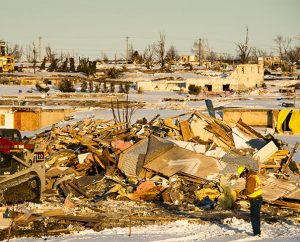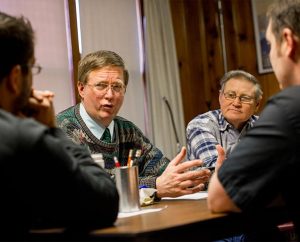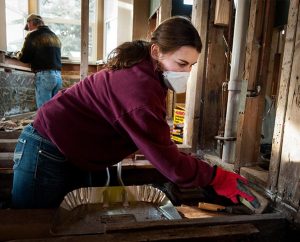By Paula Schlueter Ross
LCMS Disaster Response staff revisited disaster sites in Illinois and Colorado in recent months to assess ongoing recovery efforts and determine needs in this post-emergency, or intermediate, phase of the relief effort.
![As displayed on its sign Dec. 18, 2013, Our Savior Lutheran Church in Washington, Ill., offers "coffee, food [and] restrooms" to passersby. LCMS Disaster Response gave Our Savior a $5,000 grant to replace carpeting damaged when the church opened its doors to the community to offer refreshments to those involved in cleanup efforts following the Nov. 17 tornadoes. (LCMS Communications/Erik M. Lunsford)](https://reporter.lcms.org/wp-content/uploads/2014/01/ill-colo-our-savior-wash-sign-300x242.jpg)
The visit was the first for Johnson and Meyer to the hard-hit Illinois towns because the two were in the Philippines, assessing damages from Typhoon Haiyan, in the days surrounding the storms. Making that first visit to Illinois last November were the Rev. Bart Day, executive director of the Synod’s Office of National Mission (ONM); the Rev. Dr. Carlos Hernandez, director of LCMS Community Engagement; and Deaconess Kim Schave, assistant director for administration and operations for the ONM. (Read about that first visit here.)
On this more recent December visit, Johnson said he and Meyer were “looking for gaps,” or needs, “where insurance didn’t cover or where there is a shortage, where we could give aid and assistance.”
At Our Savior Lutheran Church in Washington, for example, they discovered that insurance only covered “a fraction” of the cost of the congregation’s destroyed organ. So LCMS Disaster Response provided a $20,000 grant on the spot to allow the congregation to purchase a new one.

The congregation received an additional $5,000 grant to replace carpeting in the church entryway and fellowship hall that was damaged when the church opened its doors to the community after the storm to offer refreshments to those involved in cleanup and response efforts.
“They really made their congregation a hub of outreach and mercy work,” said Johnson.
Our Savior is hoping to complete both grant projects before Easter, he added.
In tornado-battered New Minden, members of Saint John Lutheran Church are still worshiping about 100 yards away from their church, in a former school building that had served as a fellowship hall and is now a sanctuary, complete with folding chairs and a makeshift altar flanked by the storm-damaged cross from atop the downed steeple.
Saint John is an LCMS charter congregation with ties to the Synod’s first president, the Rev. Dr. C.F.W. Walther. Its first church building — a small, wooden structure built in the 1840s that had been moved and was being reconstructed at the time of the tornado — also was demolished by the high winds and will have to be rebuilt, “starting from scratch,” according to Johnson.

Meyer said “it was very important to have the chance to sit down with each of the pastors [the Rev. Timothy Mueller in New Minden and the Rev. Thomas Heren in Washington] and to speak with them, talk the whole event through with them again, pray with them.”
Johnson added that he was “struck wonderfully” by the way the Illinois pastors “reached out in the name of Christ to their community and to their members. It’s a beautiful example of the combination of mercy, witness and life together.”
To see photos from the Dec. 18 visit to Illinois, click here.
On Jan. 7-8, Meyer revisited areas of Colorado that were damaged by flooding in mid-September. He, Johnson and the Rev. Glenn Merritt, co-director of LCMS Disaster Response, had first seen the extensive damages on Sept. 27, some two weeks after residents were being airlifted from their mountain homes because roads had been washed away.
This time, nearly four months later, roads were open (although some were still being worked on) but some damaged homes were still uninhabited and without power, Meyer said. He expects that volunteers will be needed this summer in Boulder, Colo., and surrounding areas to help with cleanup and rebuilding/rehabilitation projects.
It was gratifying, he said, to talk with flood victims who had received assistance from a total of $271,483 in grants from LCMS Disaster Response to Mount Calvary Lutheran Church in Estes Park, Colo., and the Synod’s Rocky Mountain District.

At Mount Calvary, Meyer talked with Pastor Seth Clemmer and members of four families who had received LCMS disaster grants. One family used their grant to rent a backhoe for six months, which enabled them and several neighbors to rebuild their driveways. A local business also used the equipment to renovate its campground, which it plans to reopen this summer.
In Lafayette, Colo., Meyer met with the Rev. Paul Rhode, pastor of Eternal Savior Lutheran Church, and some families who had received LCMS grant monies. He also visited with a Lutheran student group from South Dakota State University who were helping clean damaged homes in Lyons, Colo., and with Chuck Pierce, disaster-response coordinator for the Rocky Mountain District.
“It was exciting to see some of the changes that had taken place, the good that had been done,” Meyer said of his brief visit to Colorado. “But there’s still a sense of long-term need.”
Financial contributions are still needed to help those with extensive flood damages, he added. “We’re looking at exploring the possibility of trying to assist the district with the coordination of volunteers and housing.”
Merritt said “it’s important to realize that neither one of these responses” — in Illinois and Colorado — “are complete. They’re not even close to being over. There will be needs for months. And as we move from the intermediate phase of response to the long-term phase of response, that’s where we see some of the larger expenses related to rebuilding.
“So while we put a lot of dollars out there up front to help with relief and recovery, it’s important to still have dollars available to help people in the rebuilding phase.”
Merritt encouraged those interested in helping to “stay with us in this” through prayer, financial offerings and volunteer efforts.
To see more photos from the Jan. 7-8 visit to Colorado, click here.




